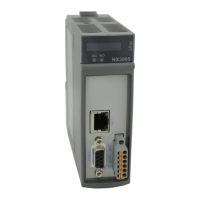5. CONFIGURATION
Device Configuration Description
Default
Value
Opções
P -> S/S -> O
Set a time reference (in
microseconds) for the time-
out check of the switch
from Pre-Operation to
Safe-Operation and from
Safe-Operation to Opera-
tional modes.
- 0 to 100000
Cyclic Unit
Set the Unit Cycle to the lo-
cal microprocessor.
Unmarked
Marked
Unmarked
Latch Unit 0
Set the Latch Unit 0 to the
local microprocessor.
Unmarked
Marked
Unmarked
Latch Unit 1
Set the Latch Unit 1 to the
local microprocessor.
Unmarked
Marked
Unmarked
Table 138: EtherCAT Slave Configurations
Notes:
AutoInc Address: This address is used only during startup, when the Master is assigning the EtherCAT addresses to the
Slaves. When, for this matter, the first telegram runs through the Slaves, each run-through Slave increases its AutoInc by 1.
The Slave with address 0 finally will receive the data.
Optional: If a Slave is declared as Optional, no error message will be created in case the device doesn’t exist in the bus
system. Thus a Station alias address must be defined and written to the EEprom. This option is only available if the option
Autoconfig Master/Slaves in the settings of the EtherCAT Master is activated and if this function is supported by the EtherCAT
Slave.
Enable Distributed Clock: If the Distributed Clock functionality is enabled, the data exchange cycle time, displayed in
the Sync Unit Cycle (µs) field will be determined by the Master Cycle Time. Thus the master clock can synchronize the data
exchange within the network. The settings for handling the synchronization unit(s) depend on the Slave.
Enable Sync 0: If this option is activated, the Sync0 synchronization unit is used. A synchronization unit describes a set
of process data which is exchanged synchronously.
Sync Unit Cycle (Sync 0): If this option is activated, the Master Cycle Time, multiplied by the chosen factor will be used
as synchronization cycle time for the slave. The Cycle Time (µs) field shows the currently set cycle time.
Shift Time: The Shift Time describes the time between the sync events (Sync0, Sync1) and the Output Valid or Input Latch
times. Writable value, if the slave supports shifting of Output Valid or Input Latch.
Enable Sync 1: If this option is selected, the synchronization unit Sync1 is used. A synchronization unit is a set of process
data which is exchange synchronously.
Sync Unit Cycle (Sync1): If this option is activated, the Master Cycle Time, multiplied by the chosen factor will be used
as synchronization cycle time for the slave. The Cycle Time (µs) field shows the currently set cycle time.
Current State: The current state is displayed. Possible values: Init, Pre-Operational, Safe-Operational and Operational.
If the state is Operational, the slave configuration has been terminated correctly.
Check Vendor ID and Product ID: By default, at startup of the system the Vendor ID and/or the Product ID will be
checked against the current configured settings. If a mismatch is detected, the bus will be stopped and no further actions will
be executed. This serves to avoid the download of an erroneous configuration. This option is intended to switch off the check,
if necessary.
SDO Access: By default there’s no timeout set for the SDO list submit action at system startup. However, if it’s necessary
to check if this action exceeds a certain time, it must be defined (in microseconds) in this field.
I -> P: By default there’s no timeout set for the state transition from Init to Pre-Operational. However, if it’s necessary to
check if this action exceeds a certain time, it must be defined (in microseconds) in this field.
P -> S / S -> O: By default there’s no timeout set for the state transition from Pre-Operational to Safe-Operational and
from Safe-Operational to Operational. However, if it’s necessary to check if this action exceeds a certain time, it must be
defined (in microseconds) in this field.
DC cycle unit control: Choose the desired option(s) concerning the Distributed Clock functions in order to define, which
should be assigned to the local microprocessor. The control is done in register 0x980 in the EtherCAT slave. The possible
settings: Cyclic Unit, Latch Unit 0, Latch Unit 1.
183

